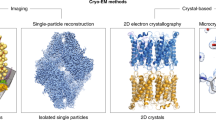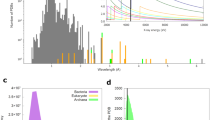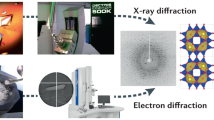Abstract
Focused X-ray beams from third generation synchrotron sources allow the possibility of data collection from previously unusable protein microcrystals of only a few microns in size.
This is a preview of subscription content, access via your institution
Access options
Subscribe to this journal
Receive 12 print issues and online access
$189.00 per year
only $15.75 per issue
Buy this article
- Purchase on Springer Link
- Instant access to full article PDF
Prices may be subject to local taxes which are calculated during checkout




Similar content being viewed by others
References
Henderson, R. The potential and limitations of neutrons, electrons and X-rays for atomic resolution microscopy of unstained biological molecules. Quart. Rev. Biophys. 28, 171–193 (1995).
Gonzalez, A. amp; Nave, C. Radiation damage in protein crystals at low temperatures. Acta Crystallogr. D50, 874–877 (1994).
Engström, P., Fiedler, S. & Riekel, C. The microfocus beamline at the ESRF. Rev. Sci. Instrum. 66, 1348–1350 (1995).
Riekel, C., Cedola, A., Heidelbach, F. & Wagner, K. Micro-diffraction experiments on single polymeric fibres by synchrotron radiation. Macromolecules 30, 1033– 1037 (1997).
Bilderback, D.H., Hoffman, S.A. & Thiel, D.J. Nanometer spatial resolution achieved in hard X-ray imaging and laue diffraction applications. Science 263, 201–203 (1994).
W. Jark, S. Di Fonzo, S. Lagomarsino, A. Cedola, E. di Fabrizio, A. Bram & C. Riekel . Submicrometer beamsize observed at the exit of an X-ray waveguide. J. Appl. Phys. 80, 4831–4836 (1996).
E.M. Landau & Jürg P. Rosenbusch (1996).Lipidic cubic phases: a novel concept for the crystallisation of membrane proteins. Proc. Natl. Acad. Sci. USA 93, 14532–14535.
Pebay-Peyroula, E., Rummel, G., Rosenbusch, J.P. and Landau, E.M. X-ray Structure of Bacteriorhodopsin at 2.5 Angstroms from microcrystals grown in lipidic cubic phases. Science 277, 676–1681 (1997).
Bram, A., Bränden, C.I., Craig, C., Snigireva, I. & Riekel, C. X-Ray diffraction from single spider silk fibre. J. Appl. Crystallogr. 30, 390–392 (1997).
Müller, M. et al. Direct observation of microfibril arrangement in a single native cellulose fiber by X-ray small-angle scattering. Macromolecules 31, 3953–3957 ( 1998).
Acknowledgements
The authors wish to thank members of the EMBL/ESRF Joint Structural Biology Group for technical help on the ESRF microfocus beamline, ID13 and E. Pebay-Peyroula and E. Landau for the images in Fig. 3.
Author information
Authors and Affiliations
Rights and permissions
About this article
Cite this article
Cusack, S., Belrhali, H., Bram, A. et al. Small is beautiful: protein micro-crystallography. Nat Struct Mol Biol 5 (Suppl 8), 634–637 (1998). https://doi.org/10.1038/1325
Issue Date:
DOI: https://doi.org/10.1038/1325
This article is cited by
-
MyD88 TIR domain higher-order assembly interactions revealed by microcrystal electron diffraction and serial femtosecond crystallography
Nature Communications (2021)
-
Visualizing drug binding interactions using microcrystal electron diffraction
Communications Biology (2020)
-
Atomic-resolution structures from fragmented protein crystals with the cryoEM method MicroED
Nature Methods (2017)
-
Langmuir–Blodgett nanotemplates for protein crystallography
Nature Protocols (2017)
-
In vivo protein crystallization opens new routes in structural biology
Nature Methods (2012)



